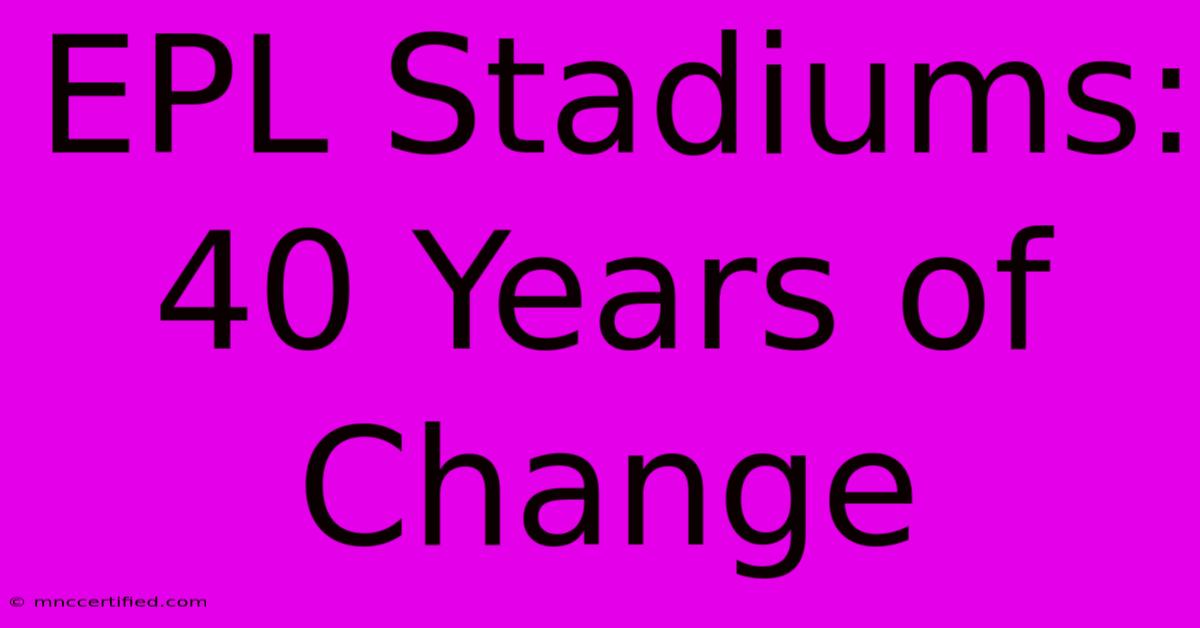EPL Stadiums: 40 Years Of Change

Table of Contents
EPL Stadiums: 40 Years of Transformation
Forty years ago, the English Premier League as we know it didn't exist. The stadiums that housed the football clubs that would soon become household names were a vastly different landscape. This article explores the dramatic evolution of EPL stadiums over the past four decades, examining the architectural shifts, capacity increases, and the impact on the fan experience. We'll delve into the key drivers of change, from safety regulations to commercialization, and highlight some iconic examples of stadium development.
From Terraces to Today's Modern Arenas: A Safety Revolution
The 1980s were a pivotal decade, marked by tragedy at football grounds like Hillsborough. This highlighted critical safety concerns and led to sweeping changes in stadium design and regulations. The Taylor Report, published in 1989, directly addressed these issues, recommending the removal of standing terraces and the introduction of all-seater stadiums. This had a profound and lasting impact on the look and feel of EPL grounds. Clubs faced significant investment in rebuilding or completely renovating their facilities to meet these new requirements. This period saw the demise of the traditional terrace and the birth of the modern, all-seater stadium.
Iconic Examples of Transformation:
- Old Trafford (Manchester United): While undergoing continuous upgrades, Old Trafford showcases the evolution, adapting to modern safety regulations while maintaining its iconic character. Its expansion demonstrates the balance between preserving heritage and accommodating growing fan bases.
- Anfield (Liverpool): Liverpool's Anfield is another prime example. Significant expansions and renovations, including the Main Stand redevelopment, highlight the commitment to upgrading infrastructure while retaining the stadium's history and atmosphere.
- Highbury (Arsenal): While no longer in use, Highbury’s transition to the Emirates Stadium represents a bold decision to trade history for a larger, more modern arena. This move is a clear reflection of the commercial pressures influencing stadium development.
The Commercialization of EPL Stadiums: More Than Just Football
The increasing commercialization of the Premier League has also significantly influenced stadium design. Modern EPL stadiums are no longer simply places to watch football; they are multi-purpose entertainment venues. This shift has resulted in:
- Increased Capacity: Expansion projects are often driven by the need to accommodate larger crowds and maximize revenue streams from ticket sales, corporate hospitality, and merchandise.
- Improved Amenities: Fans now expect a superior matchday experience, including comfortable seating, improved catering facilities, wider concourses, and enhanced accessibility features.
- Corporate Hospitality Suites: These are premium spaces offering exclusive experiences for businesses and high-net-worth individuals, representing a major revenue source for clubs.
- Stadium Naming Rights: Selling naming rights is a common strategy to secure significant financial income, further blurring the line between sporting venue and commercial enterprise.
The Impact of Sponsorships and Branding:
The integration of sponsorship and branding into stadium design is another notable change. Club crests and sponsor logos are prominently displayed, reflecting the increasing commercialization and the role of sponsors in stadium development. This is a far cry from the more simple branding of the past.
Sustainability and the Future of EPL Stadiums
Looking ahead, sustainability is becoming a key consideration in the design and operation of EPL stadiums. Clubs are increasingly adopting environmentally friendly practices, such as using renewable energy sources, improving waste management, and reducing their carbon footprint. This reflects a growing awareness of environmental responsibility amongst clubs and fans alike.
Innovations in Stadium Technology:
Technological advancements are further shaping the EPL stadium experience. Improved audio-visual systems, interactive displays, and enhanced Wi-Fi connectivity are transforming the fan experience, offering a more interactive and engaging matchday.
Conclusion: A Legacy of Change
The evolution of EPL stadiums over the past 40 years reflects a period of profound transformation. Driven by safety concerns, commercial pressures, and technological advancements, the modern EPL stadium is a vastly different entity from its predecessor. The changes, while significant, ultimately aim to enhance the fan experience while ensuring the financial sustainability of the clubs. The future promises continued innovation, placing even greater emphasis on sustainability and fan engagement. The journey from terraces to technologically advanced arenas is a testament to the dynamism and ever-evolving nature of the Premier League.

Thank you for visiting our website wich cover about EPL Stadiums: 40 Years Of Change. We hope the information provided has been useful to you. Feel free to contact us if you have any questions or need further assistance. See you next time and dont miss to bookmark.
Featured Posts
-
Geno Smiths 16 Yard Scramble
Dec 27, 2024
-
Wordle 1287 Hints And Answer
Dec 27, 2024
-
Everton Vs Man City Result And Fan Reaction
Dec 27, 2024
-
Bridgewater Back Lions New Qb
Dec 27, 2024
-
17 Great Currys Boxing Day Sale Offers
Dec 27, 2024